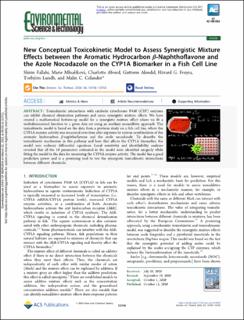| dc.contributor.author | Fallahi, Shirin | |
| dc.contributor.author | Mlnaříková, Marie | |
| dc.contributor.author | Alvord, Charlotte | |
| dc.contributor.author | Alendal, Guttorm | |
| dc.contributor.author | Frøysa, Håvard G | |
| dc.contributor.author | Lundh, Thorbjörn | |
| dc.contributor.author | Celander, Malin C. | |
| dc.date.accessioned | 2021-08-06T12:58:13Z | |
| dc.date.available | 2021-08-06T12:58:13Z | |
| dc.date.created | 2020-12-22T08:25:58Z | |
| dc.date.issued | 2020 | |
| dc.identifier.issn | 0013-936X | |
| dc.identifier.uri | https://hdl.handle.net/11250/2766826 | |
| dc.description.abstract | Toxicokinetic interactions with catabolic cytochrome P450 (CYP) enzymes can inhibit chemical elimination pathways and cause synergistic mixture effects. We have created a mathematical bottom-up model for a synergistic mixture effect where we fit a multidimensional function to a given data set using an auxiliary nonadditive approach. The toxicokinetic model is based on the data from a previous study on a fish cell line, where the CYP1A enzyme activity was measured over time after exposure to various combinations of the aromatic hydrocarbon β-naphthoflavone and the azole nocodazole. To describe the toxicokinetic mechanism in this pathway and how that affects the CYP1A biomarker, the model uses ordinary differential equations. Local sensitivity and identifiability analyses revealed that all the 10 parameters estimated in the model were identified uniquely while fitting the model to the data for measuring the CYP1A enzyme activity. The model has a good prediction power and is a promising tool to test the synergistic toxicokinetic interactions between different chemicals. | en_US |
| dc.language.iso | eng | en_US |
| dc.publisher | ACS | en_US |
| dc.rights | Navngivelse 4.0 Internasjonal | * |
| dc.rights.uri | http://creativecommons.org/licenses/by/4.0/deed.no | * |
| dc.title | New Conceptual Toxicokinetic Model to Assess Synergistic Mixture Effects between the Aromatic Hydrocarbon β-Naphthoflavone and the Azole Nocodazole on the CYP1A Biomarker in a Fish Cell Line | en_US |
| dc.type | Journal article | en_US |
| dc.type | Peer reviewed | en_US |
| dc.description.version | publishedVersion | en_US |
| dc.rights.holder | Copyright 2020 American Chemical Society | en_US |
| cristin.ispublished | true | |
| cristin.fulltext | original | |
| cristin.qualitycode | 2 | |
| dc.identifier.doi | 10.1021/acs.est.0c04839 | |
| dc.identifier.cristin | 1862554 | |
| dc.source.journal | Environmental Science and Technology | en_US |
| dc.source.pagenumber | 13748-13758 | en_US |
| dc.relation.project | Norges forskningsråd: 248840 | en_US |
| dc.identifier.citation | Environmental Science and Technology. 2020, 54(21), 13748-13758. | en_US |
| dc.source.volume | 54 | en_US |
| dc.source.issue | 21 | en_US |

